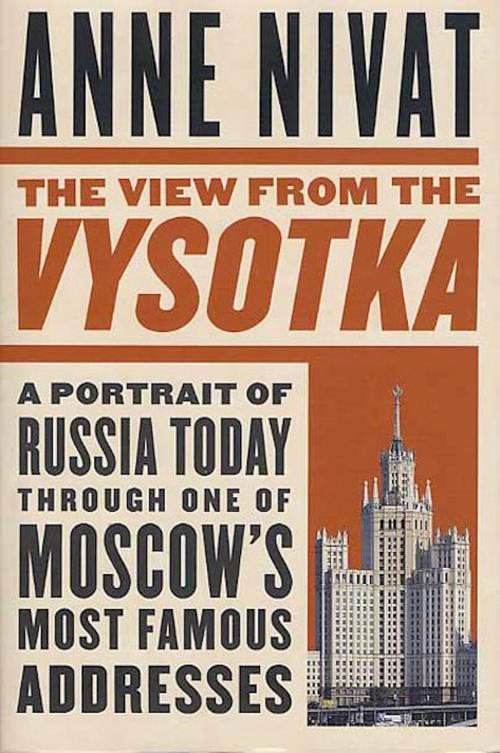The View from the Vysotka
A Portrait of Russia Today Through One of Moscow's Most Famous Addresses
Nonfiction, Social & Cultural Studies, Social Science, Sociology, Urban, History, Asian, Russia| Author: | Anne Nivat | ISBN: | 9781466865815 |
| Publisher: | St. Martin's Press | Publication: | March 11, 2014 |
| Imprint: | St. Martin's Press | Language: | English |
| Author: | Anne Nivat |
| ISBN: | 9781466865815 |
| Publisher: | St. Martin's Press |
| Publication: | March 11, 2014 |
| Imprint: | St. Martin's Press |
| Language: | English |
Completed shortly before Joseph Stalin's death in 1953, the vysotkii, or "sky houses," still dominate the Moscow skyline today. Seven in all, they were the Soviet answer to the American skyscraper, transforming the Soviet capital from a feudal backwater into the city of the future. With their soaring towers and gothic architectural details, the vysotkas were intended to be enduring monuments to the workers state and to the glories of Communism--though they were built on the backs of slave laborers and, initially, the prerogative only of the Soviet elite. Now these imposing giants lie on the fault line between a world that has vanished and one still emerging from its ruins.
When she moved to Moscow several years ago, journalist and Russia expert Anne Nivat settled into one of the vysotkas, the one that happens to overlook the Kremlin. She became fascinated by the building and learned everything she could about its history. As she got to know her neighbors and fellow tenants, Nivat discovered that they included some of the building's original inhabitants or their descendants, hand-chosen by Stalin and his henchman Lavrenti Beria (arrested and executed for high treason shortly after Stalin's death)--KGB operatives, Bolshoi ballerinas, and artists of Soviet agitprop. Living side by side with them were representatives of the "new Russia"--entrepreneurs, foreign investors, and oligarchs; as any Moscow real estate agent will tell you, Stalin-era buildings in today's market are some of the most coveted addresses in the city.
By means of this decaying but still elegant Soviet icon, Nivat gives us a way of grasping the complexities of a country struggling to come to terms with its past and define its future. She allows the tenants of her vysotka to speak for themselves, to offer their perspectives on where Russia has been and where it is going. Some are keenly nostalgic for the days when the State dictated life. Others have prospered in the confusion that has reigned since the Evil Empire's fall and look to a market-driven economy to guide Russia to the Promised Land. Still others fall some place between the two, anxious but hopeful, longing for yet also fearful of change.
Taken together, the portraits of the vysotka's inhabitants provide a panorama of Russia today. The View from the Vysotka shows us life from the inside, evoking both the forces that have swept through this vast and fascinating nation over the course of the last half-century, as well as a building that has managed to endure them.
Completed shortly before Joseph Stalin's death in 1953, the vysotkii, or "sky houses," still dominate the Moscow skyline today. Seven in all, they were the Soviet answer to the American skyscraper, transforming the Soviet capital from a feudal backwater into the city of the future. With their soaring towers and gothic architectural details, the vysotkas were intended to be enduring monuments to the workers state and to the glories of Communism--though they were built on the backs of slave laborers and, initially, the prerogative only of the Soviet elite. Now these imposing giants lie on the fault line between a world that has vanished and one still emerging from its ruins.
When she moved to Moscow several years ago, journalist and Russia expert Anne Nivat settled into one of the vysotkas, the one that happens to overlook the Kremlin. She became fascinated by the building and learned everything she could about its history. As she got to know her neighbors and fellow tenants, Nivat discovered that they included some of the building's original inhabitants or their descendants, hand-chosen by Stalin and his henchman Lavrenti Beria (arrested and executed for high treason shortly after Stalin's death)--KGB operatives, Bolshoi ballerinas, and artists of Soviet agitprop. Living side by side with them were representatives of the "new Russia"--entrepreneurs, foreign investors, and oligarchs; as any Moscow real estate agent will tell you, Stalin-era buildings in today's market are some of the most coveted addresses in the city.
By means of this decaying but still elegant Soviet icon, Nivat gives us a way of grasping the complexities of a country struggling to come to terms with its past and define its future. She allows the tenants of her vysotka to speak for themselves, to offer their perspectives on where Russia has been and where it is going. Some are keenly nostalgic for the days when the State dictated life. Others have prospered in the confusion that has reigned since the Evil Empire's fall and look to a market-driven economy to guide Russia to the Promised Land. Still others fall some place between the two, anxious but hopeful, longing for yet also fearful of change.
Taken together, the portraits of the vysotka's inhabitants provide a panorama of Russia today. The View from the Vysotka shows us life from the inside, evoking both the forces that have swept through this vast and fascinating nation over the course of the last half-century, as well as a building that has managed to endure them.















